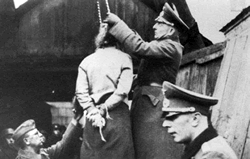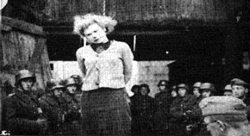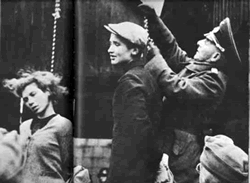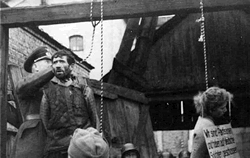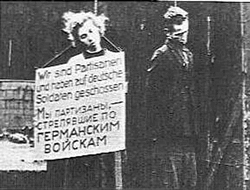Echo of '41 in Minsk: Was the Heroine a Jew?
By BILL KELLER, Special to the New York Times
Published: September 15, 1987
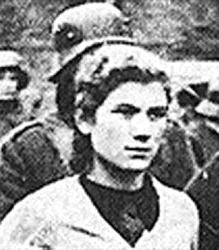
MINSK, U.S.S.R.— The sequence of photographs is among the most vivid and famous from the Nazi occupation, reproduced in Soviet textbooks, encyclopedias, films and museums.
Oct. 26, 1941: Impassive SS men lead a teen-age girl, a boy and a man through the streets of Minsk and hang them side by side at the gates of a yeast factory.
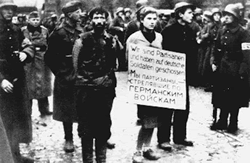
To the guides who escort tourists through the Minsk Museum of the History of the Great Patriotic War and to Byelorussian Communist Party leaders, the girl remains officially, resolutely ''nyeizvestnaya'' - ''unknown.''
But a trove of evidence compiled by Soviet journalists, backed by the testimony of survivors and endorsed by a prominent criminologist, supports the claim that the girl is Masha Bruskina, a Jew from the Minsk ghetto who was active in the Partisan resistance. The Ultimate Rejected Jew
Many Jews of Minsk regard the unknown Partisan as the ultimate ''refusenik,'' refused her place in history because she was a Jew and to honor her would be to honor the heroism of Jews in World War II.
Now there are promises of a book, a new scholarly investigation, and perhaps a lawsuit aimed at overcoming official objections and winning recognition of Masha Bruskina in her native city.
''It is only stupidity and meanness that stand in the way,'' said Ada Dikhtyar, a Moscow journalist who became swept up in the story 20 years ago and remains haunted by it. ''The times are changing, and I'm convinced that in the next year we'll finally bring this to a proper conclusion.''
The girl in the photographs is widely believed to have been the first person publicly executed during the Nazi occupation of Soviet territory. The two companions hanged alongside her -- Kirill Trus and Volodya Sherbatseyvich, Partisans of Byelorussian stock - were identified by family members within a few years of the war, and posthumously decorated. Uncle Is Painfully Certain
Twenty years ago Lev Arkadyev, a screenwriter working on a film about the war, saw the photographs in the Minsk Museum and resolved to identify the unknown Partisan. He enlisted Mrs. Dikhtyar, then a reporter for the Soviet Youth radio station ''Yunost,'' and they began a painstaking investigation.
A local reporter for the Minsk evening newspaper helped by publishing the photograph in early 1968, with a plea for information. It brought independent letters from several readers who said they recognized the girl as Masha Bruskina.
One of the most authoritative witnesses was Zahir I. Azgur, Masha Bruskina's uncle, with whom the girl lived before the war. Mr. Azgur is a professional sculptor, a connoisseur of faces.
Now 80 years old, he recalls that he recognized the picture with absolute, painful certainty. Without a Name
''That's why I rarely go to the war museum now,'' he said during a tour of his studio, which is lined to the high ceiling with idealized busts of Soviet leaders and cultural figures. ''I'm afraid to meet with Mashinka. There she's considered a person without a name and without relatives - including me.''
In all, the investigators turned up more than 20 witnesses, including Masha's father, school principal and classmates, whose signed statements and tape-recorded interviews Mrs. Dikhtyar keeps in her apartment by the Moskva River.
At the end they took their evidence to an official police expert in Moscow, a specialist in identifying war and accident victims. He presented them with a signed statement that their evidence was conclusive.
During the early occupation, the witnesses recounted, Masha Bruskina worked as a medical assistant in a hospital that the Nazis had converted to a prison camp for wounded Soviet soldiers. In league with Partisan groups operating near the city, she smuggled in civilian clothes and false documents to be used by escaping officers. Didn't Break Under Torture
Mrs. Dikhtyar sees her heroism not in any dramatic exploits but in Masha's pride and poise. She lightened her hair and used her mother's name, which was not distinctively Jewish. She reportedly refused to inform under torture, and walked to her execution with her head erect. She was 17 years old.
The results of the investigation were published in the official trade union newspaper Trud in 1968, and in the evening Minsk paper, and broadcast on a youth radio program in 1970.
Local officials in Minsk refused from the outset to cooperate, Mrs. Dikhtyar said. The local K.G.B. refused to make available records on a Soviet soldier who cracked under torture and betrayed the Minsk Partisans. The security agency asked why journalists from Moscow were poking into Byelorussian affairs.
Soon after the articles were published, the reporter for the Minsk newspaper was cited for unrelated shortcomings in his work and dismissed. Minsk officials complained to the state radio company that Ada Dikhtyar had not cleared her broadcast with the local party, and she was told she would not appear again on the radio. Museum Is Unmoved
Subsequent appeals - most recently in 1986 by the editor of a Moscow Jewish journal, Sovietish Heimland - have been rejected on the ground that the case was closed 20 years ago. In Minsk, it is as if the investigation never took place.
''The truth has never been found,'' said Alla G. Vanekeyvitch, scientific secretary of the museum in Minsk. ''There were rumors that it was Azgur's niece, but experts from the Byelorussian Ministry of Internal Affairs have examined the photographs, and they say it is not so.''
Byelorussian authorities have never disclosed details of their investigation, but it apparently did not include an effort to talk to witnesses. Mr. Azgur said no Byelorussian investigator has interviewed him.
Nikolai Stashkeyvich, a historian at the Institute of the History of the Communist Party in Minsk, said a group at his institute would re-examine the issue later this year as part of a broader, post-glasnost study of the war. Uncle's Role an Enigma
To those who hope to see Masha Bruskina recognized, one of the most disappointing features of the case is the silence of Zahir Azgur. As one of the most prominent Jews in Byelorussia, a sculptor whose work adorns the public monuments of Minsk - including a bust of Feliks Dzerzhinsky, founder of the secret police, in the park across from the local K.G.B. headquarters -and as a delegate to the Byelorussian legislature and a member of several official committees, he was well-placed to take up the matter with party officials. He has not done so.
Perhaps, as he explained in an interview, he felt it would be pretentious to make a public fuss about her when she was ''actually a victim of the war, not a heroine.''
Perhaps, as some Jews contend, he was afraid to risk being seen as a troublemaker. Mr. Azgur's instinct for avoiding confrontation is finely honed. He professes to this day to love both Stalin and the man who denounced him, Nikita Khrushchev, and when pressed about the seeming incongruity he replies that while ''truth is the most valuable thing in the world,'' it must not be confused with ''an overly straightforward approach to history.''
Mr. Azgur firmly rejects the idea that anti-Semitism has played a role in denying his niece's recognition. Bigots Don't 'Rule Our Lives'
''I deny this,'' he said. ''In our country, it's not possible. I can't say we have no anti-Semites. Certainly, we have. But they do not rule our lives here.''
Others are not so sure. Lev Ovsishcher, a heavily decorated World War II veteran who has helped organize annual memorial demonstrations in Minsk to honor Jewish war victims, says bitterly, ''This story explains why Jews who understand what is happening in this country feel the only correct decision is to leave.'' Mr. Ovsishcher recently received permission to emigrate to Israel.
Ada Dikhtyar, who is partly Jewish but considers herself Russian, believes the explanation is more complex. Part of it is anti-Semitism, she said, a feeling that was especially acute during their investigation in 1968 because of the heavy official propaganda against Israel over the 1967 Middle East war.
But she also blames a stubborn local bureaucracy loath to be told by Moscow what to do. And she feels part of the explanation lies in the chauvinism and jealousies that still run deep here, especially on the subject of the war. Making the Pain Universal
''Officially, we have never talked about the role of Byelorussians, the role of Jews, the role of Ukrainians, we have always talked of the role of the Soviet people in the war,'' she said. Thus the official view of the war does not refer to the Nazi genocide inflicted on the Jews, on the ground that it is divisive to elevate one people's suffering over others.
In Byelorussia, where by official estimates the 80,000 Jews who died were outnumbered by about 2.2 million non-Jews, there is a resentful feeling that Jews have tried to assert a monopoly over the pain of the war.
In recent months the pages of the Soviet press have opened, ever so slightly, to discussions of anti-Semitism, mostly in articles condemning Russian nationalist groups that believe in a worldwide Jewish conspiracy. Mrs. Dikhtyar believes this is an opening that will lead to Masha Bruskina's recognition.
She plans to expand her initial reporting into a book, including an account of the Byelorussian refusal to accept the results. She said she and others are considering taking the evidence to the federal prosecutor and filing suit.
Photo of an ''unknown Partisan,'' believed to be Masha Bruskina, about to be hanged by the Nazis in Minsk, U.S.S.R., in 1941; Photo of three people being marched through streets of Minsk carrying signs saying, ''We are Partisans and have shot at German soldiers,'' before being hanged by occupying German forces (Pg. A8)
1941: Masha Bruskina, Kiril Trus, and Volodia Shcherbatsevich, partisans
October 26th, 2009 Headsman
On this date in 1941, the German occupiers of Minsk conducted an infamous public hanging of partisans — perhaps the first such salutary public execution of resistance members of the war.
Jewish* 17-year-old Maria (Masha) Bruskina was the central figure of the grim tableau, and wore the placard announcing “We are partisans and have shot at German soldiers.” Evidently, she also attracted the most attention** from theonlookers to whom the scene was addressed.
Before noon, I saw the armed German and Lithuanian soldiers appear on the street. From over the bridge they escorted three people with their arms tied behind their backs. In the middle there was a girl with a sign-board on her chest. They were led up to the yeast factory gate. I noticed how calmly these people walked. The girl did not look around … The first one led to the gallows was the girl.
She was hanged with bewhiskered World War I vet Kiril Trus and the 16-year-old Volodia Shcherbatsevich. The men were members of a partisan cell organizing anti-fascist resistance; Masha Bruskina was a nurse who had been caught aiding the partisans by providing civilian clothes and papers for wounded Red Army soldiers under her care to smuggle them back to the resistance.
The scene of their deaths was captured in a series of powerful photographs taken by one of the Lithuanian Wehrmacht collaborators.
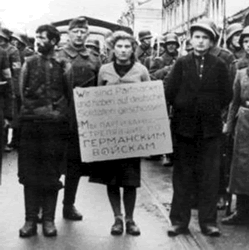
(More images here and here.)
* Phototextualities: Intersections of Photography and Narrative claims that Bruskina lightened her hair and changed her name to prevent her Jewishness affecting her resistance work; even though she was a Minsk native, her initial identification didn’t happen until 1968. The men who suffered with her were named almost immediately after the war.
** Despite the eye-catching place of the girl, she was officially unidentified for decades even after the name Masha Bruskina surfaced. In “A Historical Injustice: The Case of Masha Bruskina,” (Holocaust Genocide Studies 1997, 11:3) Nechama Tec and Daniel Weiss argued that Soviet authorities, and later Belarusian ones, found her Jewishness problematic and resisted identifying herbecause of it — while an ethnically Russian female partisan like Zoya Kosmodemyanskaya could be more conveniently accepted as a heroine. Maybe, but bureaucratic inertia and simple precedence (since Zoya Kosmodemyanskaya was known immediately while Masha Bruskina was not) are also plausible contributing factors.
A plaque unveiled at the Minsk yeast factory in 2009 finally called her Maria Bruskina.
Also on this date
• 1781: Twelve Aymara rebels
• 1964: Eric Edgar Cooke, the Night Caller
• 2000: Yopougon Massacre
• 1440: Gilles de Rais, unholy
• 1978: Seventeen officers in Somalia
• 1864: Klatsassin and four fellow Tsilhqot'ins
Possibly Related Executions:
• 1941: Zoya Kosmodemyanskaya
• 1942: Partisans by the Sonderbataillon Dirlewanger
• 1944: Hannah Szenes, who gambled on what mattered most
• 1871: The Paris Commune falls
• 1944: Marc Bloch, French historian
Entry Filed under: 20th Century,Belarus,Capital Punishment,Children,Death Penalty,Disfavored Minorities,Execution,Famous,Germany,Guerrillas,Hanged,History,Jews,Martyrs,Mature Content,Milestones,No Formal Charge,Occupation and Colonialism,Power,Public Executions,Racial and Ethnic Minorities,Soldiers,Torture,USSR,Wartime Executions
Tags: 1940s, 1941, anti-semitism, fascism, kiril trus, maria bruskina, masha bruskina, minsk,naziism, october 26, partisans, volodia shcherbatsevich, world war ii
20 thoughts on “1941: Masha Bruskina, Kiril Trus, and Volodia Shcherbatsevich, partisans”
